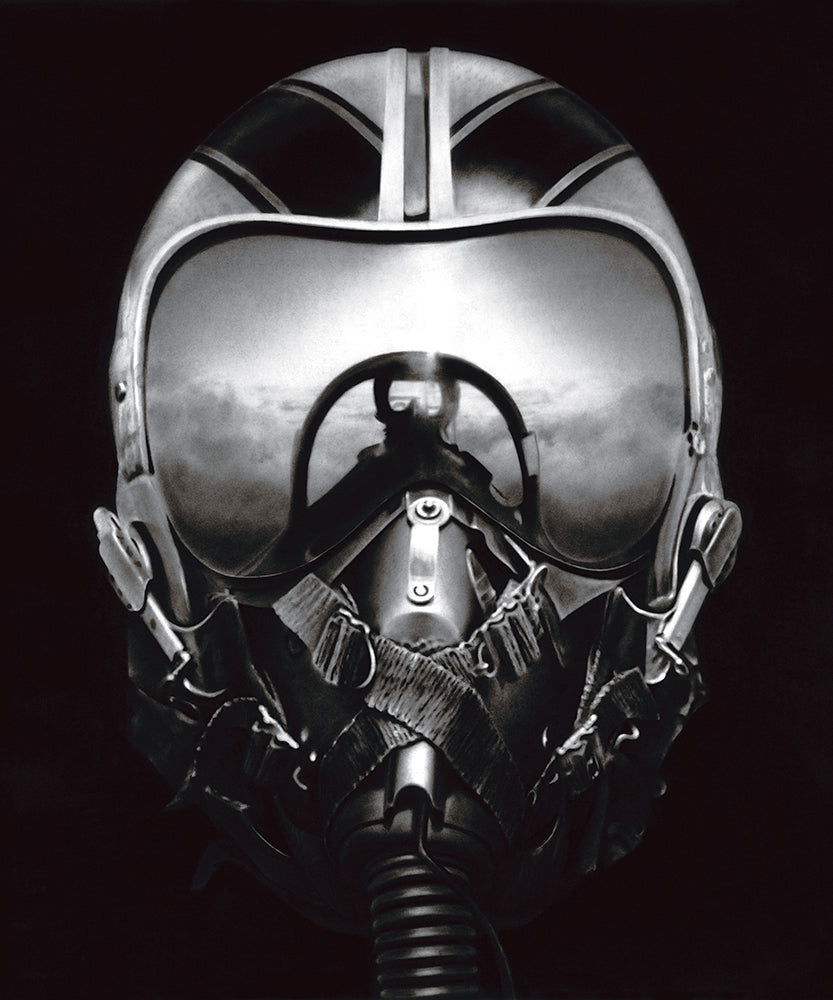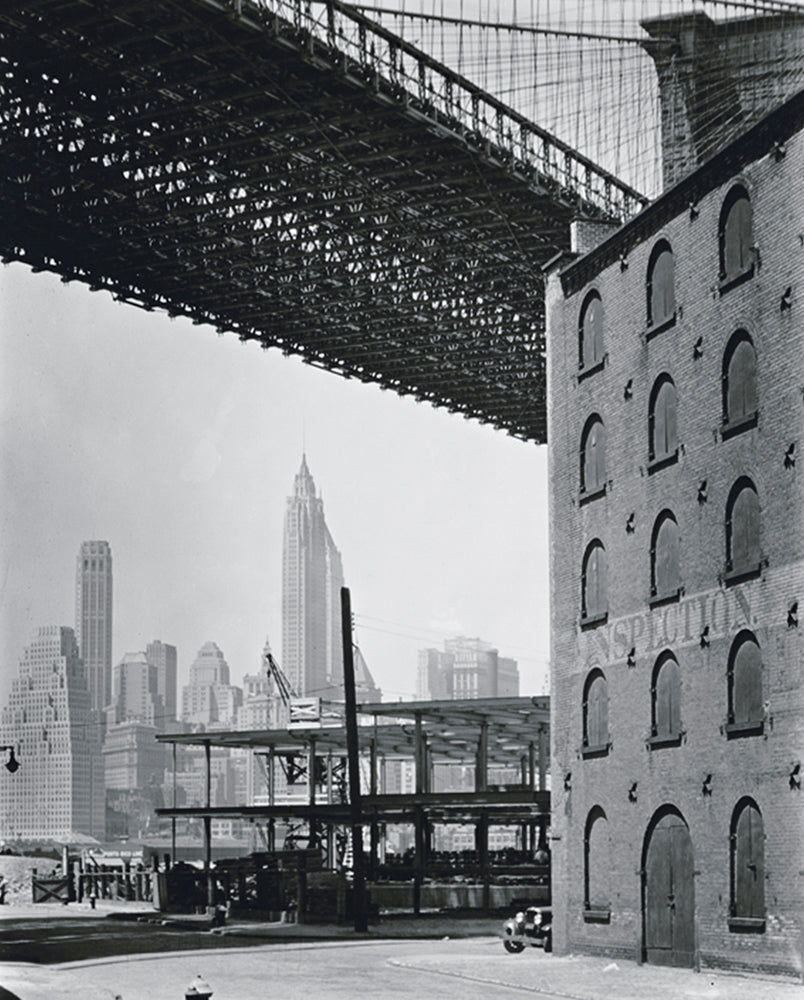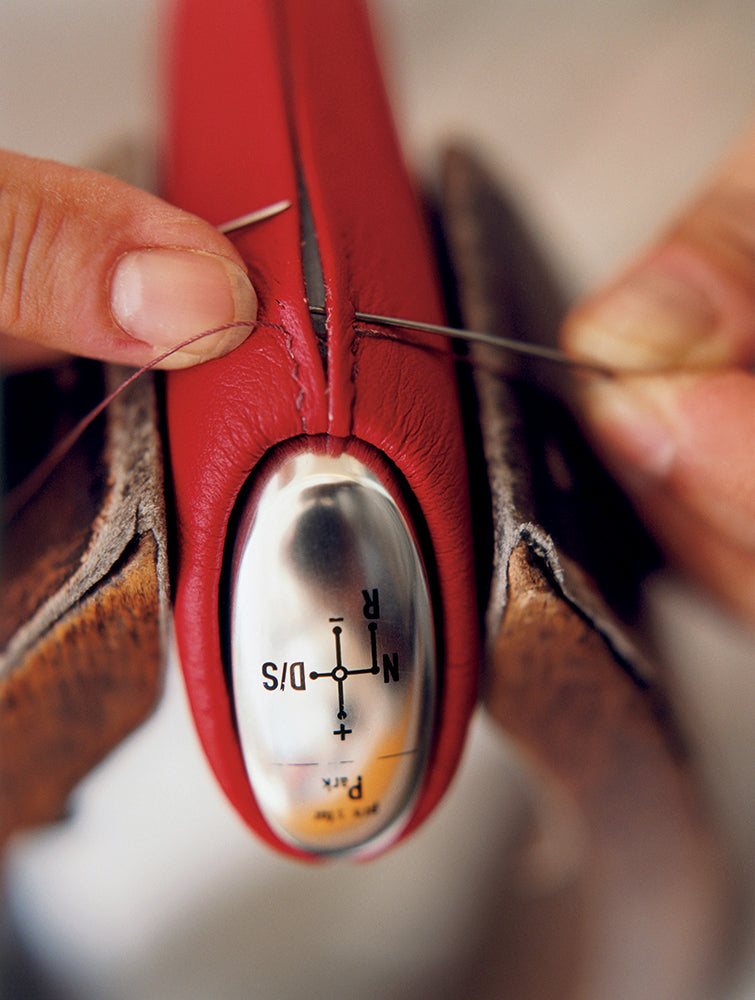
Robert Longo
ROBERT LONGO

Artist Robert Longo has culled the core of the American dream for over thirty years.
Robert Longo is a man’s artist. He makes art for men — huge and graphic black-and-white charcoal, photo-realist drawings of waving American flags, nuclear bomb explosions, monster waves, hand guns pointing right at you, sharks moving in for the kill, fighter jets, planets and the celestial cosmos. “You got the right guy, I’m totally a man,” Longo says, when offered this observation. “Everything wrong in the world is our fault.” You could say that he limns patriarchy’s sinister soul, though you’d be wrong to think that Longo, a bohemian punk surfer artist jock who wears black and plays the guitar, is anything like the thin-lipped politicians and CEOs who actually run things.
Longo simply draws the emblems of power and signs of masculinity that mark the boiling point of the U.S. cultural imperium. “It’s guy stuff, very American,” he says. “It’s about how men have found their way in the world.” In that regard Longo’s work is the perfect pendant figure to the color photography of the contemporary art world’s celebrated feminist chameleon, Cindy Sherman, who has been Longo’s close friend and compatriot ever since they met at school in the 1970s in Buffalo, N.Y. While Sherman has mastered the signs of the female, Longo trucks in icons of the male. They’re like the Adam and Eve of the 1980s avant-garde.



And for Longo, the male world is both glorious and ominous, full of that most attractive stuff from the dark side. Here, the art critics have had a field day. In a catalogue essay, the German art historian Werner Spies called Longo’s works “brutal” and referred a bit apocalyptically to “the blackness and bleakness of an art that offered no prospect of hope and redemption.” In Artforum in 2001, the “new humanist” critic Donald Kuspit, writing about Longo’s series of drawings based on photographs of Sigmund Freud’s home and office in Vienna, before he fled the Nazis in 1938, spoke of “a profoundly funereal ineffability that bespeaks the holocaust and the barbarism that began in earnest in the year of Freud’s exile.”
The guy does have his soft side, of course. He has three sons, all practically grown (and hardly any of them ever arrested). He coaches ball, teaches them to surf, gives them their lead. It’s no surprise, of course, since there’s nothing more masculine than a man cradling a baby. Didn’t Hulk Hogan play a nanny, and the Rock do a turn as the Tooth Fairy? Not insensitive to his sweet side, Longo has done pictures of red roses, of sleeping children and, epitomizing the eroticism of softness in general, images of women’s cleavage, which the artist calls the sexiest thing he can think of. “Sexuality is critical,” he says, as if to imply that his images of power might have a metaphorical, libidinal source.

Longo is part of contemporary art’s 1980s generation, whose “Neo-Expressionist” paintings and “Post-Modernist” photo-works revitalized an art scene that had seemed demoralized and unfocused after the 1960s end game that included Minimalism and Conceptual Art. The 1980s also saw the emergence of a truly international art market, which led to the market’s first big expansion and accompanying post-‘60s art boom. Works by these artists decorated the sets of such shows as Miami Vice, the artists themselves were called on to model for photo shoots in magazines like Vogue and Vanity Fair, and their prices began to soar.
Today, works by artists like Longo, Sherman, Eric Fischl, Jeff Koons, Richard Prince and a handful of others routinely bring six and seven (and even eight) figures at auction and in gallery sales. In this company, Longo’s own works might be considered a bargain. His auction record is north of $500,000, for an awesome ten-foot-wide picture of the planet Saturn and its rings set in pitch-black space, which sold in London in 2008, just before the crash. Works from his first signature series, the so-called “Men in the Cities” from 1979-1983 — black-on-white images of No Wave-style men and women, the guys in dark suits with thin ties, the gals in pumps and little black dresses, in contorted poses, as if just hit by a sniper’s bullet in some beatnik noir film — typically sell for over $100,000.

“Frozen moments,” Longo calls these early works, and he likens them to classical statuary — and it’s true, Longo’s sense of violence is not entirely of the moment. These large, black- and-white drawings were first commercially shown in 1980 at Metro Pictures in New York (which still represents the artist today) and the then-tyro Gagosian Gallery in Los Angeles. Now it seems like Longo’s silhouetted youth have entered mainstream culture as an everyday motif, turning up in ads for the iPod and in the title credits of the television soap Mad Men.
Born in 1953, Longo works in the same downtown New York loft that he has had since his early days in SoHo. A recent visit to the artist’s sixth floor studio found him alone — it was Friday, when he typically works without any of his six part-time artist-assistants — putting some refining touches on a gigan- tic charcoal image of one of Willem de Kooning’s formidable “Women.” A droning but not unpleasant music was playing on an invisible sound system, while the studio was cluttered with tripods, lights and work tables. A kitchen table is piled high with books, fiction and nonfiction both, Longo’s current reading, while a wall behind is papered with images, postcards, pictures from newspapers and magazines.


“Black-and-white is the color of truth.”
The studio itself is a striking setting, an oversized cube with whitewashed brick walls and a white enamel painted wood floor, a perfect setting for Longo’s stark but sensual pictures. One wall was filled with small delicate studies on paper, but surrounding the artist on three walls were five pictures — the de Kooning was next to an equally large drawing of a tiger’s head, its teeth bared and eyes full of fire, while opposite was a pair of tall thin drawings of a suit of armor and a female model from a custom- car showroom, with a horizontal drawing of an F-14 fighter on the final wall. The five pictures were slated not for a gallery exhibition but for the booths of his three primary dealers at the ever-more-important art fair held every December in Miami, Florida. These days, artists plan for art-fair appearances as much as they do for gallery or museum exhibitions.
In New York, Longo works with the aforementioned Metro Pictures, which was founded in 1980 and is home to the celebrated “Pictures Generation,” the subject of a major 2009 survey at the Metropolitan Museum of Art, more-or-less sealing its historical pedigree if there was ever any doubt. In Paris, Longo is represented by Thaddaeus Ropac, probably the most important international dealer on the otherwise insular scene, who has just opened a second, industrial-sized gallery, a rarity in the antique city. The third picture is slated for the booth of Galerie Hans Mayer, the Duesseldorf gallery that has long exhibited Longo’s work.

And for Longo, the male world is both glorious and ominous, full of that most attractive stuff from the dark side. The guy does have his soft side, of course.
Black-and-white has become Longo’s trademark, and it wasn’t by accident. Black-and-white is the color of truth, Longo says, referring to his youth when reports from the global trouble spots, notably Vietnam, came via black-and-white photographs in newspapers and magazines like Life. He makes his supersized drawings on heavyweight paper mounted in honeycomb aluminum, with the charcoal applied by hand, as powder and with charcoal sticks, using erasers to carve images out of the velvety blackness. He makes them large, he says, because his passions are large, and because the culture of the spectacle is large. “In America, if something is good, it’s big,” he says. These are the peak moments, the adrenaline rush. Longo refers to them as his “universe” — “a bomb explodes, a wave crashes, a rose blooms.” The postmodernist critic Hal Foster called them “moments of climax.”



Longo is also known for sculptures and theatrical performances, including a large shiny black monolith that could be straight out of 2001: A Space Odyssey, and a group reading, within a set of his own design, of Moby- Dick at a gallery in Berlin. Also a musician, he played in punk and No Wave bands in the 1980s, including one called Menthol Wars (with Richard Prince), and collaborated with avant-garde musicians like Glenn Branca and Rhys Chatham. Now he plays guitar in a group called the X-Patsys, fronted by his wife, the German film actress Barbara Sukowa (Berlin Alexanderplatz, 1980; Europa, 1991; and Hannah Arendt, 2012). Like his postmodernist colleagues David Salle and Cindy Sherman, Longo briefly ventured into Hollywood himself, making Johnny Mne- monic, based on the William Gibson short story, in 1995 with Keanu Reeves. He has called the experience “bizarre.”

“In America, if something is good, it’s big.”
His more current undertakings include a series of black-and-white “adjusted” replicas of artworks that inspire him, many of them by Abstract- Expressionist painters like de Kooning, who are considered to be the first truly American artists. These “Heritage Drawings,” as they are titled, pair with the series of “God Machines,” mural-sized (as large as 14 x 27 feet) renderings of the awe-inspiring interiors of vast religious structures like St. Peter’s in Rome and the Grand Mosque in Mecca. Together, these two series map out in images the way our entire human culture is created in time and in space. “The work makes the work,” Longo says, gnomically. “I remember waiting for the images to come in the old days, now I know exactly what I want and I search the images out.”



